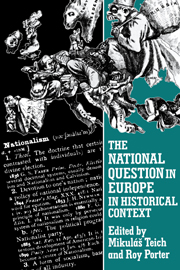Book contents
- Frontmatter
- Contents
- List of maps
- Notes on contributors
- Acknowledgements
- Introduction
- 1 The British Isles: Celt and Saxon
- 2 The making of the French nation
- 3 The national question in Italy
- 4 The roots of the national question in Spain
- 5 Shifting nationalism: Belgians, Flemings and Walloons
- 6 The nation in German history
- 7 Nationalism and nation-state in Germany
- 8 The national identity of the Austrians
- 9 The Czechs
- 10 The national question in Hungary
- 11 The union of Dalmatia with northern Croatia: a crucial question of the Croatian national integration in the nineteenth century
- 12 The national question in Poland in the twentieth century
- 13 Finland: from Napoleonic legacy to Nordic co-operation
- Index
10 - The national question in Hungary
Published online by Cambridge University Press: 30 November 2009
- Frontmatter
- Contents
- List of maps
- Notes on contributors
- Acknowledgements
- Introduction
- 1 The British Isles: Celt and Saxon
- 2 The making of the French nation
- 3 The national question in Italy
- 4 The roots of the national question in Spain
- 5 Shifting nationalism: Belgians, Flemings and Walloons
- 6 The nation in German history
- 7 Nationalism and nation-state in Germany
- 8 The national identity of the Austrians
- 9 The Czechs
- 10 The national question in Hungary
- 11 The union of Dalmatia with northern Croatia: a crucial question of the Croatian national integration in the nineteenth century
- 12 The national question in Poland in the twentieth century
- 13 Finland: from Napoleonic legacy to Nordic co-operation
- Index
Summary
‘It is true that most Slavic peoples and indeed Germanic and Romance peoples had conflicts with some of their neighbours some of the time; the Magyars had trouble with all of them most of the time.’ Robert A. Kann is right in making this statement. But he did not take into consideration the fact that Slovaks and Croatians or the Romanians and Croatians lived rather far from each other and for this reason had not many points of conflict. The Hungarians lived in the centre of the country, and thus indeed had contact and therefore conflict with all of them.
MEDIEVAL HUNGARY
From its beginnings medieval Hungary was a multiethnic state. The conquering Hungarian tribes, themselves of various ethnic origins, found Slavonic tribes here. During the course of the Middle Ages different Western settlers, mostly Germans, arrived; peasants and townspeople, and from the East, Turkish ethnic elements, reached these parts. They were given territorial privileges. Vlachs, the presentday Romanians, appeared in the eastern part of the country in Transylvania. At the turn of the eleventh and twelfth centuries, King Ladislas I and King Coloman conquered Croatia, which became a ‘Regnum Socium’ endowed with a wide-ranging autonomy.
From the late Middle Ages onwards large numbers of Southern Slavs appeared seeking refuge from the Ottoman conquest.
- Type
- Chapter
- Information
- The National Question in Europe in Historical Context , pp. 248 - 269Publisher: Cambridge University PressPrint publication year: 1993
- 2
- Cited by



